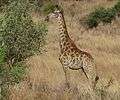South African giraffe
| South African giraffe | |
|---|---|
 | |
| A male South African giraffe in South Africa. | |
| Scientific classification | |
| Kingdom: | Animalia |
| Phylum: | Chordata |
| Clade: | Synapsida |
| Class: | Mammalia |
| Order: | Artiodactyla |
| Family: | Giraffidae |
| Genus: | Giraffa |
| Species: | G. giraffa |
| Subspecies: | G. g. giraffa |
| Trinomial name | |
| Giraffa giraffa giraffa von Schreber, 1784 | |
 | |
| Range map in tawny-orange (in the south) | |
The South African giraffe or Cape giraffe (Giraffa giraffa giraffa) is the nominate subspecies of southern giraffe raging from South Africa, Namibia, Botswana, Zimbabwe, Mozambique. It has rounded or blotched spots, some with star-like extensions on a light tan background, running down to the hooves. Once considered a subspecies of the conglomerate Giraffa camelopardalis species, recent studies identified the southern giraffe as a separate species of a reorganised Giraffa genus.[1][2]
In 2010, it was estimated that a maximum of 12,000 South African giraffes are living in the wild,[3] and around 45 are being kept in captivity.[4] In 2016, the population was approximated to 31,500 individuals in the wild.[1]
Descriptions
The South African giraffe has dark, somewhat rounded patches "with some fine projections" on a tawny background colour. The spots extend down the legs and get smaller. The median lump of males is less developed.[5]:52
Distribution and habitat
The South African giraffe is found in northern South Africa, southern Botswana, southern Zimbabwe, and south-western Mozambique.[3] After local extinctions in various places, the South African giraffes have been reintroduced in many parts of Southern Africa, including in Swaziland. They are common in both in and outside of protected areas.[6]
South African giraffes usually live in savannahs and woodlands where food plants are available. Giraffes are herbivorous animals. They feed on leaves, flowers, fruits and shoots of woody plants such as Acacia.
Threats
South African giraffes are not a threatened species, as their population is increasing.[6] On the other hand, the South African subspecies are occasionally preyed upon by Transvaal lions especially in Kruger National Park.[7] Giraffe calves can also be preyed upon by African leopards, hyenas and Cape wild dogs.
In captivity
The South African giraffes are not very common in captivity. As of 2010, there are around 45 giraffes breeding in zoos.[3]
Gallery
 Three bulls, two are fighting, Kruger Park, South Africa.
Three bulls, two are fighting, Kruger Park, South Africa. A cow giraffe in Groenkloof Nature Reserve.
A cow giraffe in Groenkloof Nature Reserve.
References
- 1 2 Fennessy J.; Bidon T.; Reuss F.; Kumar V.; Elkan P.; Nilsson M.A.; Vamberger M.; Fritz U.; Janke A. (2016). "Multi-locus Analyses Reveal Four Giraffe Species Instead of One". Current Biology. 26: 1–7. doi:10.1016/j.cub.2016.07.036.
- ↑ Brown, David M.; Brenneman, Rick A.; Koepfli, Klaus-Peter; Pollinger, John P.; Milá, Borja; Georgiadis, Nicholas J.; Louis, Edward E.; Grether, Gregory F.; Jacobs, David K. (2007-01-01). "Extensive population genetic structure in the giraffe". BMC Biology. 5: 57. doi:10.1186/1741-7007-5-57. ISSN 1741-7007. PMC 2254591
 . PMID 18154651.
. PMID 18154651. - 1 2 3 "Giraffe – The Facts: Current giraffe status?". Giraffe Conservation Foundation. Retrieved 21 December 2010.
- ↑ "Giraffa". ISIS. 2010. Retrieved 4 November 2010.
- ↑ Seymour, R. (2002) The taxonomic status of the giraffe, Giraffa camelopardalis (L. 1758), PH.D Thesis
- 1 2 Fennessy, J.; Brown, D. (2010). "Giraffa camelopardalis". IUCN Red List of Threatened Species. Version 2012.2. International Union for Conservation of Nature. Retrieved 2013-01-26.
- ↑ Owen-Smith, N.; Mills, M. G. (2008). "Predator-prey size relationships in an African large-mammal food web" (PDF). Journal of Animal Ecology. 77 (1): 173–83. doi:10.1111/j.1365-2656.2007.01314.x. PMID 18177336.
External links
-
 Media related to South African Giraffes at Wikimedia Commons
Media related to South African Giraffes at Wikimedia Commons -
 Data related to Giraffa camelopardalis giraffa at Wikispecies
Data related to Giraffa camelopardalis giraffa at Wikispecies